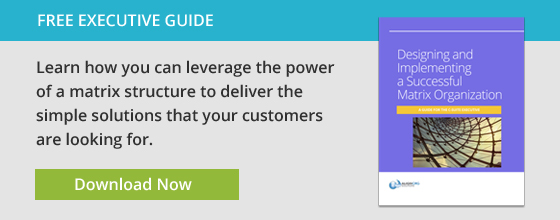Every organization struggles to make trade-offs. Naturally, it is hard to say no to good opportunities. However, intuitively we know that we can’t be everything to everybody, that our resources are limited, and that not everything will fit onto our work plate. Fortunately, many businesses recognize the need for trade-offs and want to create more focused paths that eventually lead to differentiated products and services.
So, why are trade-offs so hard and how do they lead to more differentiated offerings? Consider three reasons why you should make trade-offs in your business:
Simplifies the organization and minimizes complexity. When an organization maintains multiple offerings for lack of making trade-offs, they often don’t have the organization resources, and/or capabilities to support them and maintain differentiation. While a good organization design and clearly communicated decision-rights can help mitigate this (see Mastering the Cube 7 and our Executive Guide on Matrix organizations), nothing creates simplicity and cuts through complexity like making good trade-offs.
Additionally, narrowing an organization’s focus allows you to leverage different skills and abilities across the organization. These synergies pay big dividends in efficiency and cost reduction by freeing up valuable resources for more strategic activities.
Communicates where organizations should place their energy and focus. Have you ever heard from an employee, “Ok, but what should I do first? What is the priority of that task?” Without making and communicating trade-offs, it can be hard for employees, leaders, and the organization as a whole to know where they should place their focus.
Trade-offs allow everyone to know where the organization intends to focus and win. When an organization has a well communicated strategy that has made significant trade-offs, employees don’t need to ask where to focus their energies and instead can put all of their energy towards improving the products/services that will create market growth for the company.
Puts greater impact on the things that will help you win. Too often, we spend valuable time, resources, and energy on things that don’t bring differentiated value to the organization. We often call this “functional goodness.” Unfortunately, not all areas of a business are created strategically equal and putting resources in the right places can add much more value than building out every aspect of the organization. Trade-offs help identify those strategic areas and allow an organization to put their resources where they will have the biggest impact.
Apple has made some significant trade-offs in the past decade or two that have resulted in remarkable growth. Even with these trade-offs, we are starting to see the complexity that Apple is managing and how difficult it is to focus. So, why don’t more people do it? Unfortunately, trade-offs are often painful to make, and it can be hard to determine which trade-offs will bring the greatest value. Listed below are some common mistakes we see in organizations as they make trade-offs.
Failure to understand the market consequences of a trade-off. Years ago, Starbucks aimed to be known as one of the most premium coffees in the world. When people requested to have skim milk in their coffee rather than whole milk, Starbucks initially said no with the reasoning that skim milk would compromise the “exclusivity” and premium nature of their offering. Sticking to their strategy and value offering was a huge trade-off and put off many customers. In the end, rather than stick to their guns CEO, Charles Shultz, went with the customer, reasoning that if the customer wants it they get it.
For Starbucks, the market consequences of the trade-off didn’t make sense in the end. A trade-off taken too far or without full comprehension of how the market will react to it can cause more harm than good. To get the most out of a trade-off, you must foresee the marketplace consequences and adjust accordingly.
Settling on easy trade-offs. Making easy trade-offs feels less painful, but they don’t have the same impact that true trade-offs provide. In a recent session with a Finance group, when pushed to make trade-offs they offered “not working with bad data” as a trade-off. Sure, that is something that you will not do, but is it a marketplace advantage? Who is that hurting or who are we committing to not serve with that trade-off?
Good trade-offs are tough, usually alienate some customers, and often require organizational change. Resist the temptation to offer the bad things that you don’t want to do anyway as trade-offs. Easy trade-offs won’t create true marketplace value in the end.
Reacting to marketplace noise without assessing impact. As stated earlier, a good trade-off will cause you to lose some customers, downsize or repurpose parts of your organization, and may cause some stakeholders to complain. We worked with a banking institution that, after reviewing marketplace data, made significant changes to their organization and resourcing levels. Some of their customers screamed at them over the changes, but despite the noise from customers their revenue went up by 25%. Folks were frustrated with the customer service impacts of the changes, but in the end, they still shopped with them and even bought more because of the change.
Most trade-offs are noticeably uncomfortable and even painful for the organization and customers. However, these tough trade-offs are absolutely necessary from a marketplace perspective and are key for growth.
There is no easy way to make trade-offs nor any magic balm to make them hurt less. However, organizations that rigorously make and adhere to trade-offs can focus their resources, simplify their organization, better communicate a strategic direction to their employees, and can ultimately drive differentiation and growth in the marketplace. Differentiation comes at a cost and usually that is centered around an organization’s ability to make and commit to trade-offs.






